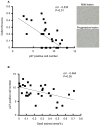Dual involvement of growth arrest-specific gene 6 in the early phase of human IgA nephropathy
- PMID: 23826128
- PMCID: PMC3691258
- DOI: 10.1371/journal.pone.0066759
Dual involvement of growth arrest-specific gene 6 in the early phase of human IgA nephropathy
Abstract
Background: Gas6 is a growth factor that causes proliferation of mesangial cells in the development of glomerulonephritis. Gas6 can bind to three kinds of receptors; Axl, Dtk, and Mer. However, their expression and functions are not entirely clear in the different glomerular cell types. Meanwhile, representative cell cycle regulatory protein p27 has been reported to be expressed in podocytes in normal glomeruli with decreased expression in proliferating glomeruli, which inversely correlated with mesangial proliferation in human IgA nephropathy (IgAN).
Methods: The aim of this study is to clarify Gas6 involvement in the progression of IgAN. Expression of Gas6/Axl/Dtk was examined in 31 biopsy proven IgAN cases. We compared the expression levels with histological severity or clinical data. Moreover, we investigated the expression of Gas6 and its receptors in cultured podocytes.
Results: In 28 of 31 cases, Gas6 was upregulated mainly in podocytes. In the other 3 cases, Gas6 expression was induced in endothelial and mesangial cells, which was similar to animal nephritis models. Among 28 podocyte type cases, the expression level of Gas6 correlated with the mesangial hypercellularity score of IgAN Oxford classification and urine protein excretion. It also inversely correlated with p27 expression in glomeruli. As for the receptors, Axl was mainly expressed in endothelial and mesangial cells, while Dtk was expressed in podocytes. In vitro, Dtk was expressed in cultured murine podocytes, and the expression of p27 was decreased by Gas6 stimulation.
Conclusions: Gas6 was uniquely upregulated in either endothelial/mesangial cells or podocytes in IgAN. The expression pattern can be used as a marker to classify IgAN. Gas6 has a possibility to be involved in not only mesangial proliferation via Axl, but also podocyte injury via Dtk in IgAN.
Conflict of interest statement
Figures







References
-
- Nagai K, Arai H, Yanagita M, Matsubara T, Kanamori H, et al. (2003) Growth arrest-specific gene 6 is involved in glomerular hypertrophy in the early stage of diabetic nephropathy. J Biol Chem 278: 18229–18234. - PubMed
-
- Nagata K, Ohashi K, Nakano T, Arita H, Zong C, et al. (1996) Identification of the product of growth arrest-specific gene 6 as a common ligand for Axl, Sky, and Mer receptor tyrosine kinases. J Biol Chem 271: 30022–30027. - PubMed
-
- Yanagita M, Ishii K, Ozaki H, Arai H, Nakano T, et al. (1999) Mechanism of inhibitory effect of warfarin in mesangial cell proliferation. J Am Soc Nephrol 10: 2503–2509. - PubMed
Publication types
MeSH terms
Substances
LinkOut - more resources
Full Text Sources
Other Literature Sources
Research Materials
Miscellaneous

